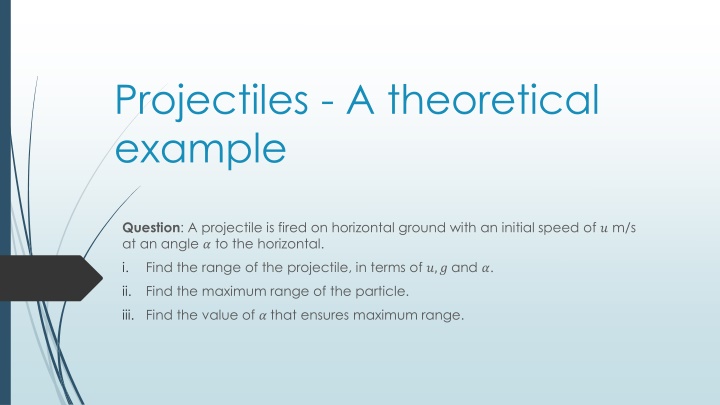
Projectile Motion: Finding Range, Maximum Range, and Optimal Angle
Learn how to calculate the range of a projectile in terms of initial speed and launch angle, determine the maximum range achievable, and identify the optimal launch angle for maximum range using trigonometry in projectile motion problems.
Download Presentation

Please find below an Image/Link to download the presentation.
The content on the website is provided AS IS for your information and personal use only. It may not be sold, licensed, or shared on other websites without obtaining consent from the author. If you encounter any issues during the download, it is possible that the publisher has removed the file from their server.
You are allowed to download the files provided on this website for personal or commercial use, subject to the condition that they are used lawfully. All files are the property of their respective owners.
The content on the website is provided AS IS for your information and personal use only. It may not be sold, licensed, or shared on other websites without obtaining consent from the author.
E N D
Presentation Transcript
Projectiles - A theoretical example Question: A projectile is fired on horizontal ground with an initial speed of ? m/s at an angle ? to the horizontal. i. Find the range of the projectile, in terms of ?,? and ?. ii. Find the maximum range of the particle. iii. Find the value of ? that ensures maximum range.
Approach: We should note the range is the horizontal displacement (? ?) when the particle lands. We can find how long it takes for the particle to land by letting ? ?= 0. This time is known as the time of flight . Before we begin any projectiles problem we should note the initial speed of the particle is ?, and this needs to be expressed as the vector: ? = ????? ? + ????? ?. Using the formula s = ?? +1 2??2: ? ?= 0 0 = ?????? ??2 0 = 2?????? ??2 we can factorise and solve for ?: 2 .apply a common denominator of 2: 0 = ? 2????? ?? 0 = ? .this is the time of projection or 0 = 2??in? ?? ?? = 2??in? ? =2????? this is the time of flight ?
Range (?) is calculated by finding ? ?at the time of flight. Remember, there is no horizontal acceleration, so the formula s = ?? +1 2??2simplifies to ? ?= ??. ? = ?????? ? = ????? 2????? ? ? =2?2???????? .this is the theoretical range, and the answer to part i. ? Part ii. asks us to find the maximum range. There are a couple of methods of doing this (including calculus), but here we will use a trigonometric approach. As ? and ? are fixed, the only variable in the range expression is ?. We need to ensure this appears only once in the expression, and then maximise this value. NB we will use the trigonometric identity 2???????? = ???2?. We can rearrange the above expression for range: ? =?2 ? 2????????
And using the trigonometric identity noted previously this gives us: ? =?2???2? ? The maximum value of the ??? of any angle is 1. Therefore: ????=?2(1) ? ????=?2 ? .this is the answer to part ii. Part iii. is asking for the angle of projection which gives maximum range. We found ????by letting ???2? = 1. We therefore solve this equation: 2? = ??? 1(1) or 2? =? 2 or ? =? 2? = 90 4(if you are asked to give your answer in radians) ? = 45
